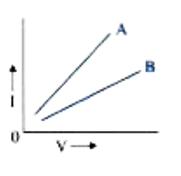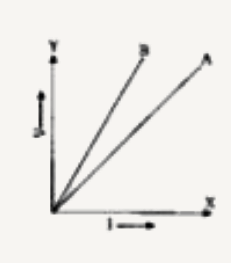Two metallic elements A and B have the following standard oxidation potentials :
A=0.40V,B=−0⋅80V. What would you expect if element A was added to an aqueous salt solution of element B ? Give a reason for your answer.
To solve the problem, we need to analyze the standard oxidation potentials of the two metallic elements A and B. The standard oxidation potential indicates the tendency of a species to lose electrons (oxidation) and can help us predict the outcome of a reaction when these two elements are mixed.
1. Identify the Standard Oxidation Potentials:
- Element A has a standard oxidation potential (E°) of +0.40 V.
- Element B has a standard oxidation potential (E°) of -0.80 V.
2. Determine the Oxidation and Reduction Reactions:
- A positive standard oxidation potential indicates that element A is likely to undergo oxidation. Therefore, A will lose electrons and be oxidized.
- A negative standard oxidation potential for element B indicates that it has a positive reduction potential. This means that B is more likely to gain electrons and be reduced.
3. Write the Half-Reactions:
- The oxidation half-reaction for element A can be written as:
A→An++ne−
- The reduction half-reaction for element B can be written as:
Bn++ne−→B
4. Combine the Half-Reactions:
- When A is added to an aqueous salt solution of B, the overall reaction can be represented as:
A+Bn+→An++B
5. Calculate the Standard Cell Potential (E°cell):
- The standard cell potential can be calculated using the formula:
E°cell=E°oxidation+E°reduction
- Here, E°oxidation=0.40V (for A) and E°reduction=0.80V (for B, since we take the absolute value of the negative potential).
- Therefore:
E°cell=0.40V+0.80V=1.20V
6. Conclusion:
- Since the standard cell potential (E°cell) is positive (1.20 V), the reaction is spontaneous. This means that when element A is added to an aqueous salt solution of element B, A will oxidize and B will reduce, leading to the formation of the products A^{n+} and B.
- Element A has a standard oxidation potential (E°) of +0.40 V.
- Element B has a standard oxidation potential (E°) of -0.80 V.
- A positive standard oxidation potential indicates that element A is likely to undergo oxidation. Therefore, A will lose electrons and be oxidized.
- A negative standard oxidation potential for element B indicates that it has a positive reduction potential. This means that B is more likely to gain electrons and be reduced.
- The oxidation half-reaction for element A can be written as:
A→An++ne−
- The reduction half-reaction for element B can be written as:
Bn++ne−→B
- When A is added to an aqueous salt solution of B, the overall reaction can be represented as:
A+Bn+→An++B
- The standard cell potential can be calculated using the formula:
E°cell=E°oxidation+E°reduction
- Here, E°oxidation=0.40V (for A) and E°reduction=0.80V (for B, since we take the absolute value of the negative potential).
- Therefore:
E°cell=0.40V+0.80V=1.20V
- Since the standard cell potential (E°cell) is positive (1.20 V), the reaction is spontaneous. This means that when element A is added to an aqueous salt solution of element B, A will oxidize and B will reduce, leading to the formation of the products A^{n+} and B.
Topper's Solved these Questions
- BOOK - ICSECHAPTER - SAMPLE PAPER 2013EXERCISE - PART-II (SECTION-A)18videos
SAMPLE PAPER 2013
- BOOK - ICSECHAPTER - SAMPLE PAPER 2013EXERCISE - PART-II (SECTION-B)16videos
SAMPLE PAPER 2013
- BOOK - ICSECHAPTER - SAMPLE PAPER 2012EXERCISE - PART-II (SECTION-C)21videos
SAMPLE PAPER 2012
- BOOK - ICSECHAPTER - SAMPLE PAPER 2014EXERCISE - PART-II (SECTION -C)21videos
SAMPLE PAPER 2014
Similar Questions
The reduction potential of a metal X is - 0.76 volts while that of Y is - 2.38 volts. Which of the two metals is a stronger reducing agent ? Give reason for your answer.
View SolutionWould you expect the first ionisation enthalpies for two isotopes of the same element to be the same or different? Justify your answer.
View SolutionFig. shows I-V graph for two conductors A and B.

Which conductor has more resistance ? Give reason to you r answer.View SolutionReduction potentials of A, B, C and D are 0.8 V, 0.79 V, 0.34 and -2.37 V and respectively. Which element displaces all the other three elements?
View SolutionLet A={x=0≤x≤2} and B={1}. Give an example of a function from A to B. Can you define a function from B and A which is onto? Give reasons for your answer.
View SolutionThe V-I graph for a series combination and for a parallel combination of two resistors is 1 shown in Fig. Which of the V two, A or B, represents the parallel combination ? Give a reason for your answer.
 View Solution
View Solution(a) What is energy ?
(b) What do you understand by the term work ?
(c) Is the energy spent in thinking or talking kind of work ? Give reason for your answer.View SolutionThe V-I graph for a series combination and for a parallel combination of two resistor is shown in the figure below. Which of the two A or B, represents the parallel combination? Give a reason for your answer.
 View Solution
View SolutionThe V-I graph for a series combination and for a parallel combination of two resistor is shown in the figure below. Which of the two A or B, represents the parallel combination? Give a reason for your answer.
 View Solution
View SolutionTwo simple pendulums A and B have equal lengths, but their bobs weigh 50 gm and 100 gm, respectively. What would be the ratio of their time periods? Give reasons for your answer.
View Solution

